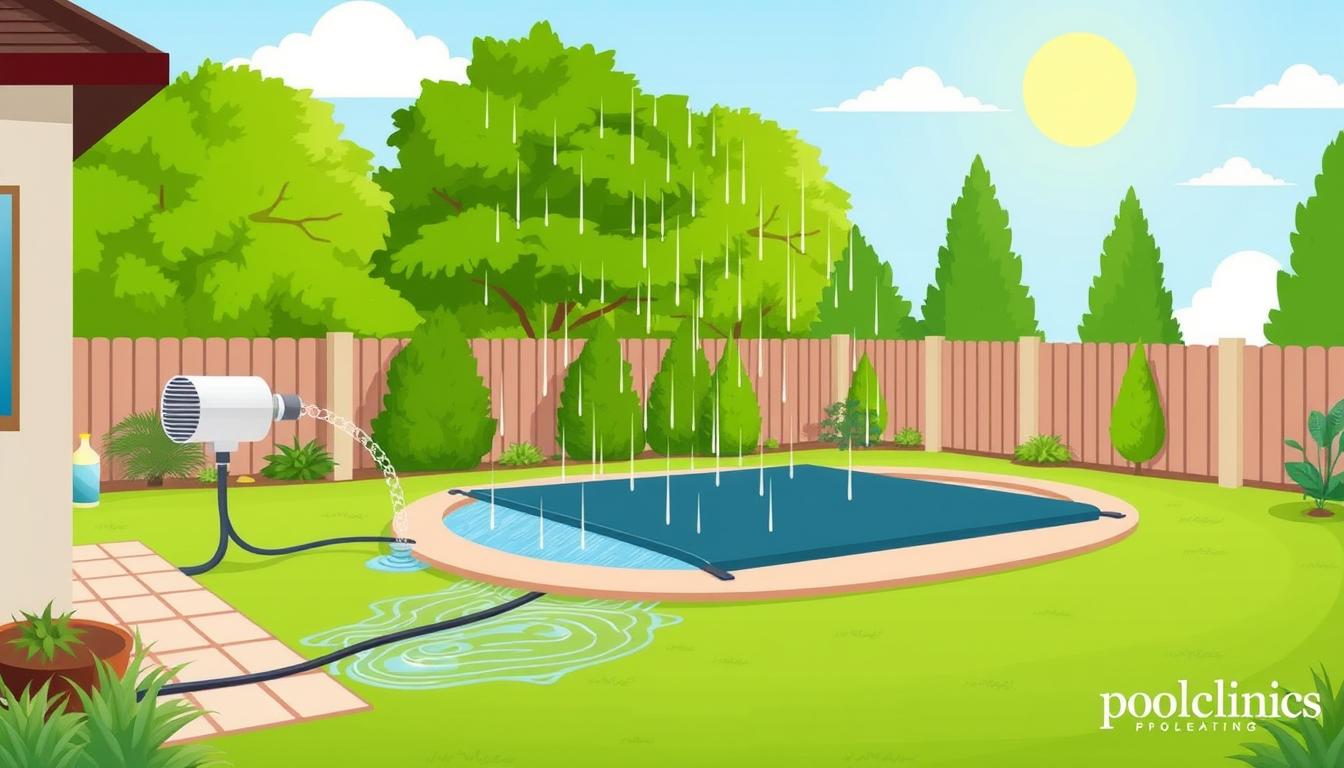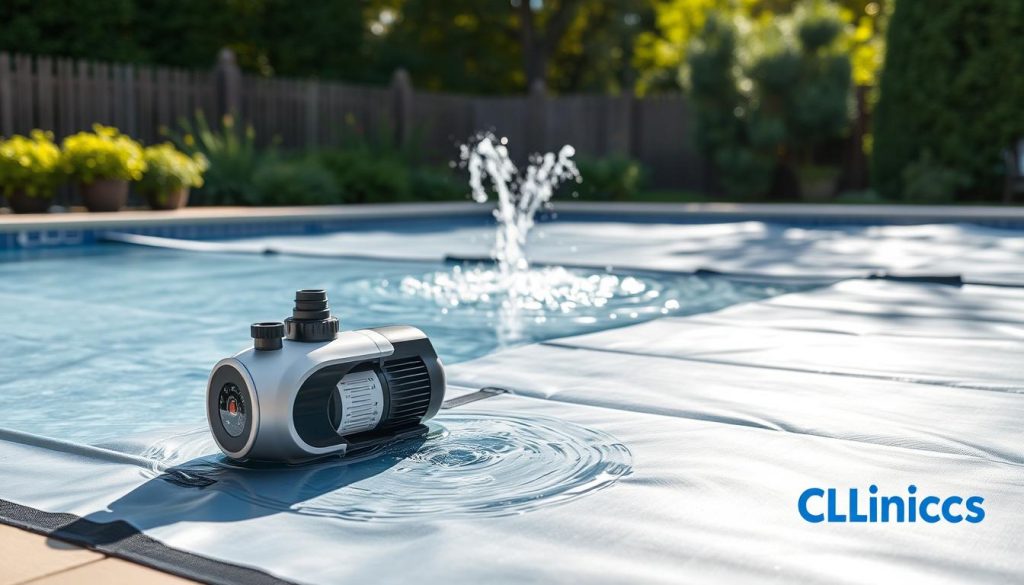
Pool cover pumps are vital for maintaining clean and safe swimming environments. These devices remove excess water from pool covers. With a reliable pump, your pool stays in top shape, ready for use anytime.
These pumps eliminate water that builds up on pool covers. This accumulation can come from rain, snow, or sprinkler runoff. By removing this water, pumps prevent cover damage and keep debris out.
Setting up a pool cover pump is easy and saves time. Most pumps have simple instructions for quick installation. Regular upkeep extends the pump’s life and ensures optimal performance.
Cleaning filters and proper off-season storage are key maintenance tasks. These steps keep your pump working efficiently for years to come.
A pool cover pump is a smart investment for pool owners. It protects your pool and ensures a clean swimming environment. Understanding its benefits helps you choose the right pump for your needs.
Key Takeaways
- Pool cover pumps remove excess water from pool covers, preventing damage and maintaining cleanliness.
- Investing in a pool cover pump saves time and effort in manually removing water.
- Easy installation and regular maintenance ensure optimal performance and longevity of the pump.
- Pool cover pumps help protect your pool investment and provide a clean, safe swimming environment.
- Understanding the benefits of a pool cover pump allows for informed decision-making when selecting the right pump for your needs.
Why Do You Need A Pool Cover Pump?
A pool cover pump is essential for every pool owner. It protects your pool cover and keeps water clean. These pumps remove excess water, preventing damage and extending your cover’s life.

Preventing Pool Cover Damage
Pool cover pumps stop water from damaging your cover. Too much water can cause sagging, stretching, and tearing. This weakens the cover and increases accident risk.
Regular pump use keeps your cover taut and secure. It also reduces the need for frequent adjustments and repairs.
Maintaining Pool Cleanliness
Pool cover pumps help keep your pool water clean. Stagnant water on covers can breed algae and bacteria. These organisms can contaminate your pool when you remove the cover.
Quickly removing standing water prevents harmful growth. This ensures your pool stays clean and safe for swimming.
| Benefit | Description |
|---|---|
| Debris Prevention | Pool cover pumps prevent debris from entering the pool, saving time and effort in cleaning. |
| Reduced Maintenance | Using a pool cover pump can lead to a decrease in maintenance time and costs for pool owners. |
| Energy Efficiency | Incorporating a pool cover pump can enhance energy efficiency, resulting in cost savings over time. |
Extending the Lifespan of Your Pool Cover
A pool cover pump is a smart investment. It prevents water buildup and algae growth, maintaining your cover’s quality. This reduces the need for frequent replacements, saving you money.
These pumps also protect your pool from harsh weather. They safeguard equipment and structures from potential damage.
“A pool cover pump is an essential tool for every pool owner. It not only keeps your pool cover in top condition but also maintains the cleanliness and safety of your pool water. Investing in a quality pool cover pump is a smart decision that will pay off in the long run.”
Choose a pump based on flow rate, power source, and portability. Consider durability, noise level, and price too. Pick a pump that fits your needs and budget for best results.
Understanding the Different Types of Pool Cover Pumps
Pool cover pumps come in various types, each with unique features. Understanding these differences is crucial for making the right choice. Let’s explore submersible, manual, and automatic pumps.
Submersible Pumps
Submersible pumps are placed directly on pool covers for efficient water removal. They can quickly clear large volumes of water, up to 350 gallons per hour. These pumps often have built-in sensors for automatic activation.
Most submersible pumps come with long power cords, typically 25 feet. This feature provides flexibility in placement and use. Models like BLACK + DECKER and Sunnora offer these capabilities.
Manual Pumps
Manual pumps are budget-friendly options for hands-on pool owners. They require manual operation using a hand pump or siphon. These pumps are less expensive and suitable for smaller pools or occasional use.
Manual pumps are portable and lightweight. This makes them easy to store and transport when not in use.
Automatic Pumps
Automatic pumps combine convenience with versatility. They have sensors that trigger pumping when water levels rise. This saves time and effort in pool cover maintenance.
These pumps also offer manual operation when needed. This gives pool owners full control over the pump’s functionality. Automatic pumps are popular for their efficiency and hassle-free operation.
| Pump Type | Key Features | Best Suited For |
|---|---|---|
| Submersible Pumps |
|
Pool owners who want an efficient and reliable solution for removing large volumes of water quickly |
| Manual Pumps |
|
Pool owners on a budget or those who prefer a hands-on approach to maintaining their pool cover |
| Automatic Pumps |
|
Pool owners who want the convenience of an automated system while maintaining control over the pump’s operation |
Consider your pool size, usage frequency, and budget when selecting a pump. Think about your preferences for convenience and maintenance. These factors will guide you to the best pump for your needs.
Factors to Consider When Selecting A Pool Cover Pump
Choosing the right pool cover pump requires careful thought. Several key factors can help you make the best choice. These include flow rate, power source, portability, durability, noise level, and price range.
By considering these aspects, you can find a pump that meets your needs. It will effectively remove water from your pool cover. You’ll also stay within your budget and performance requirements.
Flow Rate and Power Source Considerations
Flow rate is crucial when selecting a pool cover pump. It refers to how much water the pump can remove per minute. The ideal rate depends on your pool size and typical water accumulation.
A higher flow rate is usually better. It ensures efficient water removal and reduces pumping time. Your pool size and rainfall amount will influence your choice.
The power source is another important factor. Options include electric, battery-powered, and solar-powered pumps. Electric pumps offer consistent power for larger pools or rainy areas.
Battery-powered pumps are portable and great for pools without electricity. Solar-powered pumps are eco-friendly and cost-effective long-term. However, they may have lower flow rates in areas with limited sunlight.
Portability and Durability Factors
Portability matters if you have multiple pools or need to move the pump. Lightweight, easy-to-handle pumps are convenient for residential and commercial pool owners. Some pumps have built-in handles or wheels for added ease.
Durability is essential for pool cover pumps. They face exposure to water and weather. Choose pumps made from robust materials like stainless steel or corrosion-resistant plastic.
Look for models with sealed motors to prevent water damage. This feature ensures long-term reliability and performance.
Noise Level and Price Range
If noise concerns you, opt for a pump with low sound output. Submersible pumps are generally quieter than manual pumps. This is important if you have nearby neighbors or use the pump during quiet hours.
Consider your budget when selecting a pool cover pump. Costs vary based on brand, features, and power source. Find a balance between quality and affordability to meet your needs without overspending.
| Factor | Consideration |
|---|---|
| Flow Rate | Higher flow rates ensure efficient water removal and reduce pumping time |
| Power Source | Electric pumps offer consistent power, battery-powered pumps provide portability, and solar-powered pumps are eco-friendly |
| Portability | Lightweight and easy-to-handle pumps are convenient for multiple pools or locations |
| Durability | Choose pumps made from robust materials like stainless steel or corrosion-resistant plastic for longevity |
| Noise Level | Submersible pumps tend to be quieter compared to manual pumps during operation |
| Price Range | Balance quality and affordability to get a pump that meets your needs without overspending |
Conclusion
A pool cover pump is crucial for every pool owner. It removes excess water from the cover, preventing damage and keeping the pool clean. There are different types available, including submersible, manual, and automatic pumps.
When selecting a pump, consider flow rate, power source, and portability. Other factors include durability, noise level, and price. Choose a pump that balances performance, convenience, and affordability.
A high-quality pump saves time and extends your pool cover’s life. It also contributes to the overall longevity of your pool. By using a cover pump, you’re protecting your investment.
Add a pool cover pump to your regular maintenance routine. It’s a smart step towards a clean and safe swimming environment. Get a reliable pool cover pump today to enjoy your pool for years to come.







